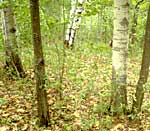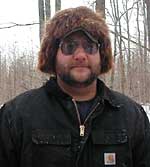By Stephanie Hemphill
Minnesota Public Radio
February 5, 2002
The Sierra Club is suing the U.S. Forest Service. The group wants the U.S. District Court in western Michigan to block aspen logging on the national forests in Michigan, Wisconsin, and Minnesota. The Sierra Club says the Forest Service allows too much clearcutting of aspen, holding back re-growth of native pine and hardwood forests.
| |
|
|
|
||
The lawsuit is a sign of the times - American forests are in transition.
IT WASN'T ALWAYS LIKE THIS
The vast pineries and hardwood stands of northern Michigan, Wisconsin, and Minnesota were cut down in the late 19th and early 20th centuries. Loggers cut the big trees to build the burgeoning cities of the Midwest.
When the trees were gone, wildfires swept through the slash. After the fires, aspen grew up thick and fast. Aspen, or "popple," as many Minnesotans call it, is a tree that thrives in disturbed landscapes. In scientific terms, it's a pioneer species.
If nature were allowed to take its course, other species would grow up beneath the aspen. Pines and spruce, maples and oaks would eventually dominate the forest again.
But in the 1970s and 1980s, industry found uses for the ubiquitous aspen. Paper mills were built in communities across northeastern Minnesota, and "engineered wood" mills became an important part of the region's economy. They glue together tiny bits of wood to make sheets like plywood.
Every day, loggers cut down vast swaths of young aspen to feed the mills. And more young aspen grows up in its place. Today, aspen and birch make up 80 percent of northeastern Minnesota's forests. Before logging, the woods were about 10 percent aspen.
| |
|
|
|
||
THE LAWSUIT
The Sierra Club says the U.S. Forest Service is bowing to pressure from the paper companies and chipboard mills. The group says the government is managing its forests to keep the aspen coming.
If the Forest Service would allow more of the aspen to die off and give way to pines and hardwoods, the Sierra Club says, it would boost the population of wolves and mountain lions, among other threatened species. These animals, which are endangered or nonexistent in most of their original range, can only thrive in large expanses of older forests.
But other animals have been doing well in the young aspen forest. Ruffed grouse and deer are popular with hunters, and they thrive in young aspen woods.
Marvin Roberson, a forest policy specialist with the Michigan chapter of the Sierra Club, says there's no danger they will become extinct.
"There may be some concern on some people's parts that the levels may be lower than they would like for hunting purposes," Roberson says. "But the species are not in trouble for survival."
There are lots of grouse and deer now. But some hunters worry about the future. Rick Horton, a wildlife biologist for the Minnesota chapter of the Ruffed Grouse Society, says if the Forest Service allows too much of the woods to get old, it could hurt animals that need young forest to survive.
|
"The number of jobs produced by aspen cutting that goes to pulp and paper is very small, when you consider the huge amount of land and wood that goes into these things."
- Marvin Roberson, the Sierra Club |
"We want to ensure that we have a good balance of both young and old forests of different types, to provide for maximum biodiversity," says Horton. "What some people seem to forget is that young forests are an important component of biodiversity - very important for a whole host of wildlife species."
The Sierra Club says it's not only animals that are at stake, but jobs for people. Marvin Roberson says older forests would provide more jobs than the young aspen stands do.
"The number of jobs produced by aspen cutting that goes to pulp and paper is very small, when you consider the huge amount of land and wood that goes into these things," Roberson says. "They're highly automated industries. They don't employ nearly the number of people - per cord of wood or per dollar invested - that later-stage hardwoods and sawlog value-added industries do."
Sawlogs are turned into lumber for home-building, cabinets, or furniture.
In Minnesota, about 22,000 people work in the lumber industry. About the same number work for firms making paper products. Only about 6,000 people work at paper mills and chipboard plants.
But the mills devour many more trees than the lumber industry does. About three-quarters of the wood cut in Minnesota goes to pulp mills and board plants.
Wayne Brandt, a spokesman for the trade organization, Minnesota Forest Industries, says although mills employ relatively small numbers of workers, they're good jobs.
"Paper mills have been very stable employers even in very very difficult times," says Brandt. "They provide very high wages, much higher than many of the alternatives that people have in the forested regions. They're important jobs to the economy."
| |
|
|
|
||
INDUSTRY ADJUSTS
The mills expect to run into a shortage of mature aspen in the next 10 to 20 years. Some mills are investing in equipment to allow them to use other trees. Brandt says chipboard plants can use nearly one third non-aspens, and some of the paper mills can also use alternative woods.
"The Minnesota industry has grown up to utilize the resource that's here as it's grown," Brandt says. "We've never expected that anybody, the agencies or anybody, had to try and grow us a certain type of tree."
The industry will continue to adapt as the forest changes.
A few loggers are adapting by down-sizing and specializing. Entrepreneur Joe Jewett runs Copperhead Road Logging and Lumber. It's a one-man operation, and he likes it that way. He used to work for his parents, harvesting aspen for pulp. Now he specializes in cutting hardwoods for value-added products like paneling and venetian blinds. That way he can cut fewer trees for a similar return.
At his harvest site in Aitkin County, Jewett says there's room in the woods for aspen, basswood, and everything else.
"Some sites are aspen sites, like right over there where the aspen was harvested out and is now regenerating," he says, gesturing down the logging track to a stand of 10-year-old aspen. "There's hardwood sites and aspen sites, so there always will be aspen to harvest."
Jewett says the small sawlog industry can co-exist with the giant mills. If nature is allowed to take its course, operations like Jewett's could represent an increasingly important part of the economy in the Northwoods.
More from MPRMore Information



